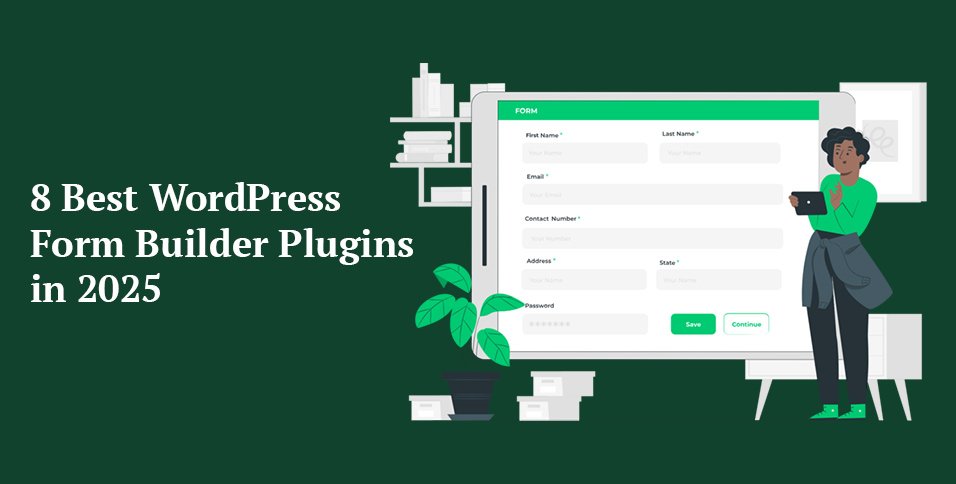Forms shape the web interactions, such as contact queries to payments. By 2025, the creation of dynamic and friendly forms will be easy with WordPress form builder plugins. These tools come with a drag-and-drop editor which simplifies the form designing process. Create forms with Elementor for seamless integration, enhancing engagement and conversions.
Form builders are essential with 62% of all websites built on WordPress, according to W3Techs. They simplify the capture of lead and data collection. Google Cloud Platform infrastructure ensures fast, secure form processing. This article has discussed eight best plugins, these are technical strengths as far as creating forms using Elementor is concerned.
WordPress Form Builder Plugins: An Overview
Plugins are used to build interactive WordPress forms, without codes. They provide drag-and-drop features, templates, and integration such as API email marketing. Create forms with Elementor using widgets for contact or payment forms. Google Cloud Platform infrastructure boosts performance with scalable servers.
These plugins are in demand since 70% of websites require forms, based on Wilson data via WPForms. They have conditional logic, analytics, and spam protection. Google Cloud Platform infrastructure ensures low latency. Create forms with Elementor to match site branding, driving 10-15% higher conversions.
The 8 Best WordPress Form Builder Plugins:
1. Elementor Form Builder
Create forms with Elementor using its Pro widget. The drag-and-drop editor has 10+ field types. Google Cloud Platform infrastructure powers Elementor Hosting for speed. It is connected with Mailchimp through API. The cost begins at 59/year.
Conditional logic makes form fields personal. The design accuracy is guaranteed by real-time previews. Forms without Elementor do not have styling options. Google Cloud Platform infrastructure reduces latency. Create forms with Elementor for responsive, branded designs. For Example: A widget builds a multi-step contact form.
No Elementor, no custom forms. This discourages participation by users. Lack of extensive integrations impede automation. Google Cloud Platform infrastructure ensures uptime. Create forms with Elementor to boost conversions. For Example: A form uses conditional logic to show relevant fields.
2. WPForms
There is a drag-and-drop developer in WPForms. It has 1200+ contact form templates. Google Cloud Platform infrastructure enhances performance via caching. It allows Stripe payments. It costs $49.50/year to start with.
Irrelevant fields are concealed by WPForms condition logic. It applies reCAPTCHA to block spam. Forms without WPForms do not have any templates. Google Cloud Platform infrastructure ensures fast submissions. The analytics of WPForms monitor the form performance. For Example: A template creates a payment form with validation.
Forms are rudimentary without WPForms. This lowers conversions. Functionality is limited by fewer features. Google Cloud Platform infrastructure supports scalability. The responsive designs of WPForms are mobile-friendly. For Example: A form adjusts fields for smartphone screens.
3. Gravity Forms
Gravity forms construct complicated forms. It includes more than 30 validating field types. Google Cloud Platform infrastructure powers hosting for speed. It is automatable using Zapier. It costs $59/year.
It allows easy design via its drag-and-drop editor. User experiences are customized depending on conditions. Complicated forms have to be coded without Gravity Forms. Google Cloud Platform infrastructure ensures reliability. The plug-ins by Gravity Forms provide functionality. For Example: A form uses logic to show payment fields.
The absence of the Gravity Forms restricts advanced options. This minimizes participation. Manual Based Operational processes cause delay. Google Cloud Platform infrastructure boosts uptime. The analytics of Gravity Forms follow submissions. For Example: A survey form collects data with dynamic fields.
4. Formidable Forms
Formidable Forms is strong in forms that are driven by data. It facilitates quizzes and calculations. Google Cloud Platform infrastructure optimizes performance. It is connected to Salesforce through API. The price is $39.50/year.
It has a drag-and-drop builder that uses multi-page forms. The domains of AI provoke a reaction. Without Formidable, there is no superior logic in forms. Google Cloud Platform infrastructure ensures fast processing. The templates of Formidable accelerate the design. For Example: A form calculates totals based on inputs.
Forms without Formidable lose calculations. This constraints functionality. Generic forms lower interaction. Google Cloud Platform infrastructure supports scalability. Formidable responsive designs fit to devices. For Example: A quiz form adjusts for mobile screens.
5. Ninja Forms
Ninja Forms has a clean interface. It adds 25 reCAPTCHA field types. Google Cloud Platform infrastructure enhances hosting performance. It is an in-built Mailchimp campaign. It is priced at 49/year.
It makes form creation simple using its drag and drop editor. Inclusion monitoring performs an entry tracking. Forms are inflexible without Ninja Forms. Google Cloud Platform infrastructure ensures low latency. Add-ons of Ninja Forms extend properties. For Example: A form submits data to an email API.
Forms do not have customization without Ninja Forms. This reduces conversions. There is a low level of integration that discourages automation. Google Cloud Platform infrastructure provides uptime. The mobile-friendly and responsive layouts of Ninja Forms are responsive. For Example: A contact form adapts fields for tablets.
6. Fluent Forms
Fluent Forms is speed-oriented. Its drag and drop builder makes conversational forms. Google Cloud Platform infrastructure supports fast hosting. It is connected with Slack as a notification tool. It costs a starting price of $59/year.
The surveys are supported by its 48+ field types. The user experience is boosted by conditional logic. In absence of Fluent Forms, forms are not being interactive. Google Cloud Platform infrastructure ensures scalability. The analytics of Fluent Forms monitor performance. For Example: A form triggers notifications based on submissions.
Forms are inert without Fluent Forms. This reduces participation. Low functionality can be reduced by limited features. Google Cloud Platform infrastructure boosts reliability. Responsive designs used by Fluent Forms are compatible with devices. For Example: A survey form adjusts layout for phones.
7. MetForm
MetForm is an addition to Elementor. It provides 40+ custom-form widgets. Google Cloud Platform infrastructure powers Elementor Hosting. It is integrated with GetResponse in terms of campaigns. The plans begin at 39/year.
The drag-and-drop editor of MetForm is added to Elementor. It facilitates the multi-step forms. Forms cannot use Elementor without MetForm. Google Cloud Platform infrastructure ensures speed. MetForm has reCAPTCHA to stop spam. For Example: A widget creates a booking form with validation.
When MetForm is not installed, forms do not have Elementor styling. This makes it less attractive. Automation is hindered by limited integrations. Google Cloud Platform infrastructure provides uptime. The responsive designs of MetForm are mobile-friendly. For Example: A form adjusts fields for small screens.
8. Forminator
It is a form builder, which is free in Forminator. It has quizzes and forms of payment. Google Cloud Platform infrastructure enhances hosting speed. It is integrated with PayPal to make payments. It has a free price and premium options.
Its drag-and-drop editor makes interactive forms. Honey pot fields are used in spam protection. Forms without Forminator are dull. Google Cloud Platform infrastructure ensures fast submissions. Analytics in Forminator monitors the engagement. For Example: A quiz form collects responses with logic.
With Forminator, forms are simple. This restricts interaction. Few features lessen functionality. Google Cloud Platform infrastructure supports scalability. Responsible designs of Forminator are suited to devices. For Example: A payment form adjusts for mobile screens.
How Important are Form Builders in 2025:
1. Lead Generation
Form builders are able to capture data of users. They generate conditional forms to specific leads. Their absence slows growth through manual data collection. For Example: A multi-step form filters leads based on user input.
2. User Engagement
Interactive forms enhance interaction with visitors. Elements such as sliders and quizzes help to draw in users. In the absence of engagement tools, users churn right away. For Example: A quiz form adapts questions based on responses.
3. Data Security
Form creators come with spam defense such as reCAPTCHA. They encrypt information by using SSL. Forms without security are vulnerable to breakages. For Example: A honeypot field blocks automated spam submissions.
Conclusion
WordPress form builder plugins are the key to engagement in 2025. Create forms with Elementor for seamless, branded designs. Google Cloud Platform infrastructure ensures speed and security. Such form builders as WPForms and Formidable provide enhanced capabilities that increase conversions and user engagement.
Proper selection of plugins helps to increase the functioning of the site. Conditional logic, integrations, and responsive design should be of highest priority. Forms are necessary in 70% of the locations, which makes the tools essential. Create forms with Elementor and leverage Google Cloud Platform infrastructure to stay competitive and drive success.
Also read: Top 5 Juices for Weight Loss: Quick, Yummy, & Simple!



















